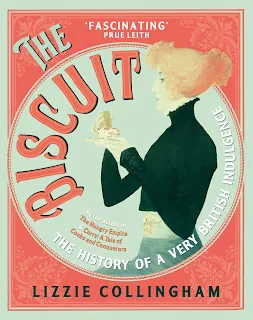I love biscuits and every time I opened this book I wanted to eat one. The Biscuit Book - The History of a Very British Indulgence by Lizzie Collingham is naturally full of biscuits, sponge fingers, biscotti, shortbread, macaroons, crackers, digestives, pretzels, rusks, scones, wafers, waffles and much much more.
This is a serious history book that focuses on the origin of particular biscuits, the production and manufacturing of biscuits, the distribution of biscuits, the effect of class and the conditions of workers employed in biscuit factories.
There's quite a lot on the history of sugar, and while you might assume this to be dry, Collingham provides many interesting sweet morsels like this one:
"During the seventeenth century, treacle replaced honey in gingerbread. Treacle is the English name for the molasses or sweet uncrystallised syrup that drains out during the production of sugar as it slowly crystallises into a solid mass. From the 1650s, raw brown muscovado sugar from Britain's new sugar colony in Barbados flooded the London sugar market, and by 1692 there were 38 sugar refineries in the capital, processing the brown sugar cones into white refined sugar. A by-product was plenty of cheap molasses." Page 58-59To find out what they did with all of that molasses, you'll have to read the book.
Did you know that biscuits with aniseed and caraway seeds were thought to aid digestion and give the consumer fresh breath? Thankfully aniseed and caraway seeds fell out of favour with the French influence of citrus zest for flavourings and the author covers many more cases like this where various countries and cultures have influenced or adopted certain biscuit recipes. Collingham takes us beyond country or culture of origin to explain the how and why those particular items rose to favour in the first place.
This includes describing the origin of biscuit names as they arise in the text, and explaining the continental confusion between biscuits, crackers and cookies:
"What confuses us today is terminology: what the English would now call biscuits, the Americans call crackers or cookies; what the English think of as scones, southern Americans call biscuits. This confusion can be unravelled by tracing the introduction of Dutch bakery traditions into the Americas." Page 86Further on, the author goes on to explain that:
"the American use of the terms cracker and cookie are the result of a far more straightforward Americanisation of Dutch words." Page 91Collingham also provides a detailed and thorough history on the evolution of ship's biscuits and hardtack and outlines just how crucial they were to explorers, travellers, traders and of course the war effort. The twentieth century production of biscuits during the two world wars and the produce shortages that preceded and followed them are also covered in great detail, but I'll admit finding these sections somewhat hard going.
Bakers, cooks and home chefs will appreciate the many recipes included throughout, and I was astounded (okay, that's probably the wrong word, perhaps horrified?) to read that many of the original biscuit recipes required hours of whisking.
"But it was the invention of the metal whisk to replace the bundle of twigs used to beat confections in the still room that marked a big step forward in biscuit making. Seventeenth-century instructions specified that at each stage of the process the biscuit dough had to be beaten for at least two hours. In the 1760s, [Elizabeth] Raffald suggested that a mere half an hour with the far more efficient metal whisk was sufficient for each stage, thus reducing the beating time from 6 to 1 1/2 hours." Page 102Imagine being the person whisking away for hours and if you're a servant, not even being able to taste the fruits of your labour. A detailed history of production, design and distribution of the biscuit tin was fascinating and reading about the many uses for them around the world was an eye opener.
I will say The Biscuit Book - The History of a Very British Indulgence is heavily focussed on war and the effect on biscuits and vice versa, and when I learned the author had published The Taste of War: World War II and The Battle for Food and The Hungry Empire: How Britain's Quest for Food Shaped the Modern World, it became clear that this is the author's area of specialist interest and expertise.
Those looking for a brief history on some of their favourite biccies (Australian slang) like Jaffa Cakes, Kit Kats, Jammie Dodgers, Wagon Wheels, Ryvita and Marie biscuits will find it here, however be prepared to learn way more than anticipated along the way.
The Biscuit Book is recommended for history buffs and biscuit lovers while other readers may find this a little dry and stale.





































This sounds like a really interesting read to me, especially the Dutch connections!
ReplyDeleteGlad I was able to tempt you Marg, it's a delicious read ;-)
Delete